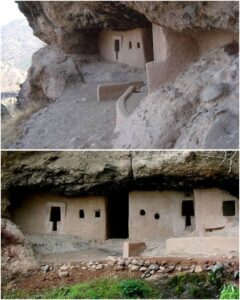Introduction to the Huapoca Ruins
Nestled deep within the Sierra Madre Mountains of Chihuahua, Mexico, the Huapoca ruins are an ancient cliff-dwelling complex attributed to the Mogollon culture. These rock shelters were not only places of residence but also serve as symbols of the Mogollon people’s adaptability and creativity in challenging terrain and climates.
The Huapoca ruins, which include renowned sites like Cueva de la Serpiente and Cueva Grande, were constructed within natural rock overhangs, taking advantage of the existing landscape. Archaeological studies suggest that the Mogollon people inhabited these sites from around 1200 to 1450 CE. They developed unique construction techniques and survival strategies that reveal much about their way of life.

Cliff Architecture: Precision in Construction
The Skilled Building Techniques of the Mogollon
The cliff dwellings at the Huapoca site were built along rock faces, using natural crevices and overhangs as structural support. This construction method protected the houses from extreme weather, such as heavy rains and intense sunlight. Mogollon builders displayed remarkable skill in crafting sturdy stone walls and using clay for reinforcement, creating stable and enduring structures.
Adapting to Rugged Terrain
These structures showcase not only architectural ingenuity but also the Mogollon people’s understanding of their environment. By skillfully using steep and rugged cliffs, they created safer living spaces shielded from natural threats and other communities. The elevated dwellings also helped regulate interior temperatures, keeping them warm in winter and cool in summer.

Mogollon Life and Survival Techniques
Water Sources and Small-Scale Agriculture
Although living in a dry region, the Mogollon people found ways to make use of nearby water sources, such as rivers and mountain springs, for both drinking and farming. They developed small-scale agriculture, cultivating crops like corn, beans, and squash, which are drought-resistant and nutritionally dense staples.
Hunting and Gathering
In addition to farming, the Mogollon maintained a subsistence lifestyle that relied on hunting and gathering. Small animals, seeds, and wild fruits were essential dietary supplements, enabling them to survive in a harsh environment. Their combination of farming and foraging highlights a flexible and sustainable livelihood system.

Artifacts and Cultural Value
Pottery and Stone Tools
During excavations at Huapoca, archaeologists have unearthed pottery, stone tools, and remnants of woven fabrics. The pottery vessels, adorned with intricate designs, showcase the Mogollon’s artistic culture. Stone tools like knives and arrowheads reveal their advanced stonecrafting skills, aiding them in daily life and hunting.
Weaving and Artistic Expression
The remnants of woven textiles also offer valuable insights into the Mogollon’s craftsmanship and aesthetic sensibilities. They used natural fibers, dyeing them with plant-based colors, and created intricate patterns that reflect both their artistry and cultural views on beauty.
The Historical Significance and Resilience of the Mogollon People
Huapoca Ruins: A Testimony to Survival Skills
The Huapoca site is not only a place of habitation but also a testament to the Mogollon people’s resilience in a harsh environment. By developing diverse survival methods and sustainable agricultural practices, they demonstrated that with creativity and an understanding of nature, people can endure and thrive under any circumstances.
Lessons for Future Generations
The Huapoca ruins offer valuable lessons to future generations about adaptability and living in harmony with nature. The enduring structures stand as proof that sustainability and self-sufficiency are key to preserving culture and surviving in challenging environments.

Conclusion
The Huapoca ruins of the Mogollon people stand as a historical testimony to human adaptability and ingenuity in challenging natural settings. The architecture, survival techniques, and artifacts found at this site are not only valuable for research but also serve as inspiration, highlighting the strength and wisdom of ancient cultures.
